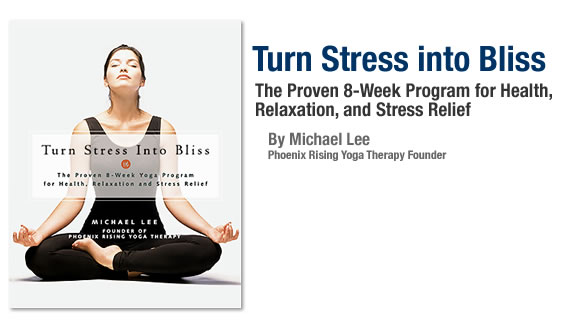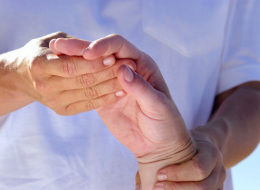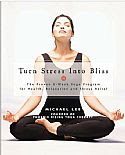Sunday, July 3, 2011
New Blog
Saturday, November 28, 2009
Holiday Stress
Monday, September 14, 2009
Sunday, May 10, 2009
New Website
Thursday, April 23, 2009
Yoga and Stress - Maximizing Benefits
1. TIME AND PLACE – To get the most from my yoga practice I do it in the same place and at roughly the same time every morning. I make sure there is plenty of time available by getting up early enough to complete my hour long ritual each before anything else happens in my day. It does not have to be an hour. That’s just my preference. As little as 15 minutes can work as long as it happens daily and is a focused time.
2. WARM UP – I don’t start right away with trying to get deeply into the essence. Instead I spend a few minutes with vigorous movement and breath. You can just jump around if you want, or shake your body, do random movements or whatever just plain feels good to wake up your body and your breath. There is a section in “Turn Stress Into Bliss” that describes a warm up routine that I like to use.
3. BREATHING – Once you begin your yoga practice pay as much attention to your breath as you do to your body. Long, slow, deep, inhalations followed by relaxed full exhalations that are coordinated with you body movements work best.
4. PLAY THE EDGE – Remove all force, strain, and trying from your practice. Instead come gently to your edge in each posture using your breath to help you slowly get there. Some years ago I wrote an article on Playing The Edge that was published in Yoga Journal. If you are a yoga teacher and would like to copy it for your students, email me. It may help them add another dimension to their approach to yoga. I like to think of my yoga practice as “effortless effort”.
5. FOCUS AWARENESS – Once you arrive at your edge, practice being present physically and emotionally to whatever you might be experiencing right NOW.
6. ACCEPT – Whatever you notice, accept it. This is what is happening now and all that needs to happen.
7. CHOOSE - Decide in the moment how to be present to what is happening. You might feel an urge to move into a harder edge. Do you really want to do this? Choose. Practice making different choices and see what happens as a result.
8. PAUSE AND REFLECT – After each posture and again at the end of your practice take a few moments to reflect on your experience and what you noticed. In Phoenix Rising Yoga Therapy one key element of the process is what we call Integration. It’s one of the key features of the practice that help make it such an effective modality.
All of the above tips are described in detail in Turn Stress into Bliss. Another good way for new yoga students to learn how to work with yoga this way is to find a yoga teacher or yoga therapist who can teach and guide them with a private session.
If you find this blog post helpful, please email it to your friends, students, or colleagues by clicking on the little mail envelope below. Also if you have any comments or questions please use the comment link below. I love to hear from my readers.
Thursday, April 9, 2009
Yoga and Stress
Just about everyone knows and believes that if you want to reduce stress you should take up yoga, right? Is yoga the new panacea? Will it really make a big difference? And what kind of yoga? And what about the millions of us who just don’t see ourselves on a yoga mat – ever! Are our concepts of yoga misguided or do we really not fit the mold?
There is no question that regular yoga practice will make a difference to one’s life and it really doesn’t matter what kind of yoga is practiced. For the majority this will usually be a physical approach to yoga and the benefits will in turn be primarily physical. They include better respiration, enhanced circulation, greater flexibility, and an overall feeling of physical well being. All of this will contribute to reducing stress. However, when the rubber hits the road in day to day life in areas where stress is likely to be triggered – at the office or at home – it just might not be enough to make much difference. Yes, you read that right! All the effort of getting to that yoga class and practicing diligently just might not prevent you from that angry outburst, that frustrated look, or that deep feeling of despair and helplessness.
Why not?
Well, for one thing you may not have paid sufficient attention to aspects of yoga that will make a difference. Let me tell a story about a yoga colleague I’ll call Vince although that was not his real name.
Vince began practicing yoga in his twenties and loved it. He worked hard at his asana practice and very soon became one of the most adept students in his class. Vince was also very short tempered and impatient but was seen as someone who was strong, and was always able to push through and make things happen. Nobody would ever describe Vince as a happy person. He had a stern look on his face and if you looked closely enough you could sense a person in emotional pain. Success was important to Vince. All of these attitudes came to the yoga mat with him. He gave himself two weeks to get his forehead to his toes in the sitting forward bend and got there with days to spare by pushing his body through the pain and practicing the posture for hours each day. He became a yoga teacher, and because of his incredible physical flexibility and prowess as a yogi in the physical arena, was featured in a prominent yoga magazine.
I met him on the conference circuit and over several years got to know him just a little. Interestingly, he had attracted a following of students who were in many ways just like him – driven to succeed and focused on attaining perfection with the physical form of yoga. Ten years after meeting Vince his conversation had not changed. He was still frustrated with many aspects of his life, still striving for perfection in all things, and still criticizing his students for not working hard enough.
To me there are two very important aspects to the practice of yoga – the “form” and the “essence”. Vince focused on the form almost exclusively and as a result missed most of the benefits that the essence of yoga might have brought to his life. Now I’m not saying that form is not important. It is! We do need to know how to work with our bodies as we practice yoga. But form is really only a tool, not an end in itself. As well as good form we also need to learn how to engage the practice of yoga in ways that take us to deeper levels of awareness at emotional, mental, and spiritual levels. If we are obsessed with the form of the practice, this is unlikely to happen.
So how do we do that? Check back here in a few days for the next blog post and I’ll share some tips with you. And the good news is that if you don’t get hung up on the form that yoga should take, you, or practically anyone you know, can engage the practice and use it as an effective stress management tool. You don’t need a body like Vince’s!
Wednesday, April 1, 2009
Teenage Stress
A recent UCLA study reports that stress experienced in the teen years can have a negative affect on physical health in later years – particularly in relation to cardio-vascular disease. I guess this finding is not so alarming on the surface. What is concerning though is the significant increase in stress being experienced by a large percentage of teens in recent years.
As a father of five over a thirty year span of my life I have seen the changes first hand. The life of an average seventeen year old today can be very different than it was for someone that age in 1985. It seems today there is more pressure to perform in many areas of life and not just academically. Social networks fueled by instant messaging and cell phones have expanded to the point that thirty percent of some teens waking hours is spent in cyber conversation. Throw in on top of this the usual homework concerns, getting along with parents, dealing with first love, dressing to be cool, a changing body and other issues and it's not surprising that many teens succumb to "over the top" stress. No longer does the home provide a safe haven and a respite from the outside stressors that many teens are facing. With this happening it's easy as a parent to just give up and muddle through as best we can. At the same time, and ever the optimist, I'm always on the lookout for ways to make it easier for my kids. As much as possible I prioritize creating or providing experiences for them that will help them better deal with all they might be facing. Some work and some don't.
I was in Colorado last weekend to visit my 17 year old who is taking part in what is called The Rocky Mountain Semester at the High Mountain Institute. I sat in his English class listening to him and his peers read poems they had written about their experience so far. Already they have been on two expeditions - one to the Canyons of Utah and one in the high mountains of Colorado in the middle of winter. On the winter expedition they were out for nine days, sleeping in snow caves and quigloos they had shoveled out of the snow pack, carrying their food and shelter on sleds and using skins and telemark skis to climb and descend peaks up to 14,000 feet in elevation. They wrote about this different experience of life and how serene and fulfilled they felt both during and after. The hardships endured in just getting warm and going to the bathroom in the snow at fifteen below, didn't seem to bother them that much and were rarely highlighted. Instead, many of the poems gave voice to a camaraderie not ever before experienced and a connection to others that gave them a sense of wellbeing and support. They talked about learning how to take care of themselves and each other and be present to whatever they faced. The poems were eloquent and deep and clearly not influenced by anything other than the spirit of the poet. For two months they have been without a cell phone, and have very limited (and slow) internet access. On their main campus they sleep in a small cabin with nine others and wake several times a night to fuel the wood stove that heats it. I couldn't help but notice how alive and happy they all appeared. I have never seen my son so full of life and so comfortable with his surroundings, friends, schoolwork, and the leadership skills he's developing. There was no overwhelming stress here.
I began to ask myself a question. How could I create at home, an environment that produced a similar feel? And then I realized I was discrediting my son, his colleagues, and the faculty by even asking the question. Why? Because each one of them had pro-actively created what they were experiencing. It didn't just happen by chance and it was not my job to try to create it for anyone other than myself somewhere else. In my conversation with my son before I left this became more apparent as he told me how he had changed. He was learning how to create his world the way he wanted it regardless of where in the wider world he might find himself. He was being given the tools to help him do it, but no one was doing it for him. At present he was fortunate to be in the company of others doing it too but knowing that he will be ready to go solo when the time comes.
I left feeling like a burden had been lifted from my shoulders and that my son was becoming equipped to handle whatever stress or problems might come his way in life. This felt so much more powerful to me than my trying to shelter him from these things. As a fellow parent, you might want to ask what experiences you might be able to offer to your teen - ones that can empower them to deal with the stress and the complexities of life that are bound to come their way.
As well as great programs like the one at High Mountain Institute, there are many other resources available. Check out listings for summer camps that offer a leadership component. Look for nature and wilderness experiences that use the backdrop of nature as a tool for empowerment. At a more basic level, many yoga or martial arts programs for teens offer components that support them in developing the strengths to handle adversity.
Here are two additional links
Appalachian Mountain Club Teen Wilderness Adventures
Northwaters Wilderness Program






